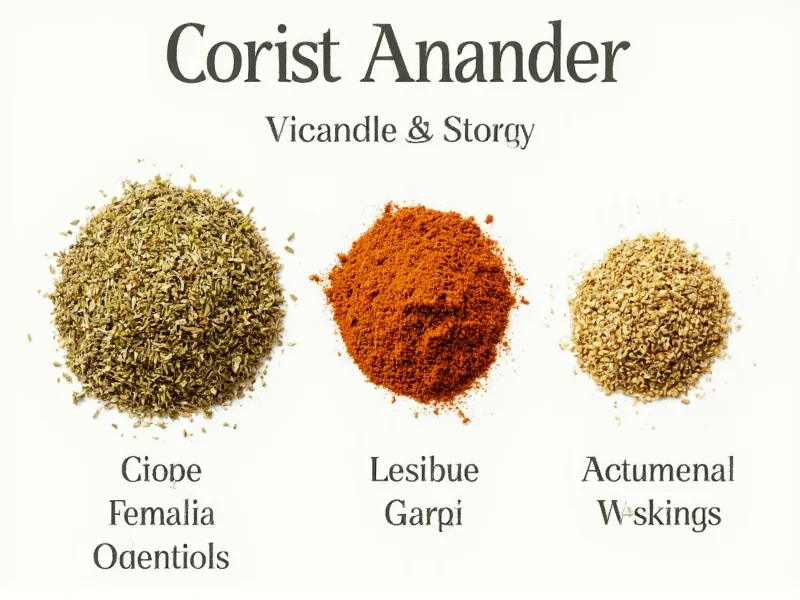Running out of coriander mid-recipe can derail your cooking plans, but several effective alternatives exist for both fresh cilantro and dried coriander seeds. Understanding which substitute works best for your specific dish ensures your flavors remain authentic and balanced. This guide provides practical solutions based on flavor chemistry and culinary applications.
Understanding Coriander's Flavor Profile
Coriander refers to two distinct ingredients from the same plant: fresh cilantro leaves and dried coriander seeds. Each has unique flavor characteristics that determine appropriate substitutes.
Fresh cilantro delivers bright, citrusy notes with a slight peppery finish, essential in Mexican, Indian, and Southeast Asian cuisines. Dried coriander seeds offer warm, nutty, and slightly citrusy flavors that form the backbone of many spice blends. Recognizing these differences is crucial when selecting what spice can i substitute for coriander in your specific recipe.
Top Substitutes for Fresh Cilantro
When your recipe calls for fresh coriander leaves (cilantro), these alternatives maintain visual appeal and flavor balance:
| Substitute | Best For | Substitution Ratio | Flavor Notes |
|---|---|---|---|
| Parsley | General garnish, salsas | 1:1 volume | Milder, grassier flavor without citrus notes |
| Basil | Thai, Vietnamese dishes | 1:1 volume | Sweeter with anise notes; use Thai basil for closer match |
| Culantro | Caribbean, Latin American dishes | 1:1 volume | Stronger cilantro flavor; use half amount |
| Green onions | Stir-fries, soups | 2-3 tbsp per 1 tbsp cilantro | Mild onion flavor with similar texture |
Best Replacements for Dried Coriander Seeds
Dried coriander seed substitutes require different considerations since they're used in spice blends and cooked dishes. The best coriander substitute for curry and other spice-heavy dishes includes:
Cumin
Cumin provides the closest earthy, warm notes to coriander seeds. While cumin has a stronger, more pungent flavor, it shares similar citrus undertones. Use cumin when making what to use instead of coriander in Indian cooking. Start with half the amount of cumin compared to coriander, then adjust to taste.
Garam Masala
This Indian spice blend typically contains coriander along with cumin, cardamom, and cloves. Garam masala works well as a dried coriander alternative for spice blends, especially in curries. Substitute 1:1, but reduce other spices in your recipe since garam masala contains multiple components.
Caraway Seeds
Caraway shares coriander's citrusy notes with a slightly more anise-like finish. It works particularly well in Middle Eastern and Mediterranean dishes where coriander seed is used. Substitute 1:1, but toast caraway seeds first to enhance their warm characteristics.
Substitution Guide by Cuisine
Choosing the right substitute depends on your specific dish. Understanding what spice can i substitute for coriander in different culinary contexts ensures better results:
- Mexican dishes: Use parsley or a combination of parsley and lime zest for fresh cilantro. For dried coriander in spice rubs, use equal parts cumin and paprika.
- Indian curries: Garam masala works best as a dried coriander seed replacement. For fresh cilantro garnish, try a mix of parsley and mint.
- Thai recipes: Basil (especially Thai basil) makes the best fresh cilantro substitute. For dried coriander in curry pastes, use equal parts cumin and ground turmeric.
- Middle Eastern cooking: Caraway seeds work well as a dried coriander substitute. For fresh applications, try a combination of parsley and dill.
Practical Substitution Ratios
Getting the proportions right matters when you need a coriander powder substitute. Follow these guidelines:
- Fresh cilantro to dried: 3 parts fresh = 1 part dried (but never substitute dried for fresh in garnishes)
- Dried coriander to cumin: Start with ½ tsp cumin per 1 tsp coriander, then adjust
- Fresh cilantro to parsley: 1:1 volume, but add ½ tsp lime juice per tablespoon for citrus notes
- Dried coriander to garam masala: 1:1, but reduce other spices by 25%
Special Considerations
Several factors affect your choice of what to use instead of coriander:
Fresh vs. Dried Confusion: Many recipes don't specify whether they need fresh cilantro or dried coriander seeds. Check the context - if it's a garnish or salsa ingredient, it's fresh cilantro. If it's in a spice blend or curry base, it's dried coriander seeds.
Allergy Considerations: For those with coriander allergies, culantro may cause similar reactions since it's in the same plant family. Opt for completely different herbs like parsley or dill.
Flavor Layering: When making how to replace coriander in Mexican dishes, combine substitutes for better results. For example, use parsley with a pinch of cumin and lime zest to mimic cilantro's complex profile.
Taste Testing Tips
Always taste as you adjust substitutions. Add substitute spices gradually, especially potent ones like cumin. For fresh herb substitutions, add them at the end of cooking to preserve their delicate flavors. Remember that dried spice substitutes need time to bloom in oil or liquid, so add them earlier in the cooking process than fresh herb alternatives.
When Substitutes Won't Work
Some dishes rely so heavily on coriander's unique flavor that substitutes fall short. Chimichurri sauce without cilantro and certain Indian chutneys lose their essential character. In these cases, consider modifying the entire recipe rather than forcing a substitution. Exploring what spice can i substitute for coriander sometimes means acknowledging when no perfect replacement exists.











 浙公网安备
33010002000092号
浙公网安备
33010002000092号 浙B2-20120091-4
浙B2-20120091-4